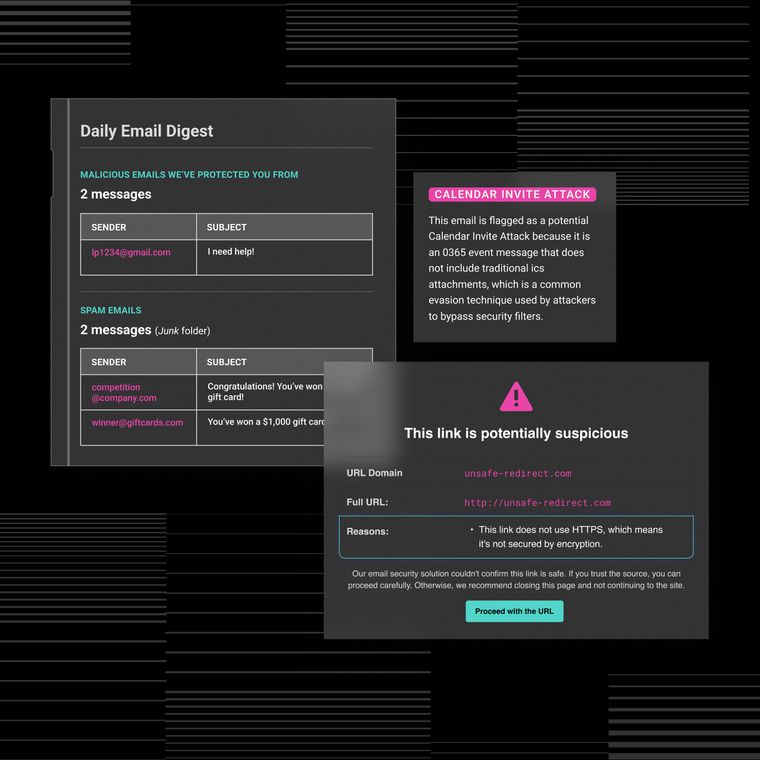Sandbox Environment Best Practices for Cloud and SaaS Security
Follow best practices for building secure sandbox environments across cloud and SaaS.
October 15, 2025
Cloud and SaaS attacks now outpace traditional sandbox defenses, creating critical security gaps that expose organizations to advanced threats. Modern attackers bypass file-based detection entirely, targeting identity tokens, exploiting API vulnerabilities, and weaponizing phishing links that contain no payload to detonate.
Traditional sandboxes excel at analyzing files but fail against today's dominant attack vectors. Attackers exploit resource-intensive analysis pipelines, evade virtualized environments, and pivot through API calls that never trigger sandbox analysis.
When a phishing attack succeeds, security teams struggle with the following steps because their detection systems missed the payload-free social engineering tactics that compromised personal information and targeted specific email addresses. This article provides five practical approaches that transform sandbox security from isolated file analysis to comprehensive SaaS defense.
1. Align Sandbox Policies With Real-World Cloud and SaaS Workflows
Cloud sandboxes fail when their setup doesn't match how your actual systems work. Security teams think "isolated" means "safe," but poor configurations and excessive user permissions create vulnerabilities that attackers exploit.
Traditional virus scanning misses today's threats completely. Attackers steal authentication tokens, abuse shared documents, and exploit connections between apps, the areas your sandbox never checks. Modern protection requires automatically testing suspicious links, regularly reviewing app permissions, and monitoring how different systems communicate.
The test environments need strict controls: separate spaces for each developer, automatic resource limits, blocked external connections, and scheduled deletion of unused systems. When security teams monitor activity across these controlled environments, you can focus on the attacks that file scanning misses. This turns sandbox testing from a checkbox exercise into absolute protection.
2. Integrate Sandboxing With Identity, Email, and Access Controls
Sandbox security breaks down when testing happens separately from your real user authentication and email systems. Proper protection connects analysis directly to how people actually access your systems.
Here's how to integrate sandboxes with your security infrastructure:
User Authentication Controls: Require the same login process for sandbox access as production systems, including two-factor authentication. Create temporary test accounts that automatically expire, and use fake user data instead of real employee information for testing suspicious emails.
Match Real Security Rules: Apply your actual security policies to test environments. When malware tries to steal data during testing, automatically lock related accounts. Include the same location restrictions and device checks you use in production.
Connect Analysis to User Behavior: Link sandbox findings to normal user activity patterns across email and cloud apps. When testing reveals threats, immediately block those attacks in your live systems.
This integrated approach transforms isolated testing into active protection that strengthens your entire security setup.
3. Automate Analysis, Tagging, and Lifecycle Management
Automation transforms security testing from hours of manual work into instant, continuous protection. Modern systems automatically analyze threats and manage resources, eliminating delays and human error.
When suspicious files or links appear, automated workflows immediately send them for analysis. Cloud systems simultaneously check behavior and reputation, catching malicious activity in seconds rather than hours. Detection triggers instant responses, such as isolating threats, locking compromised accounts, alerting users, and creating detailed incident reports with all evidence pre-analyzed.
Infrastructure automation extends beyond threat detection. Systems automatically label new test environments with owner and expiration dates, enforce security rules, and delete expired resources nightly. This prevents forgotten test systems from becoming security risks or cost overruns.
This dual automation approach delivers faster threat detection, cleaner operations, and consistent security. This way, security teams catch more threats while spending less time on repetitive tasks, focusing instead on investigating genuinely unusual activities.
4. Monitor Vendor and Third-Party Content Flows
Vendor and third-party content create supply chain vulnerabilities that testing environments must address through strict controls and continuous monitoring. Here’s what security teams need to do:
Isolate each vendor test in separate environments to contain potential threats and block public internet access and use private connections only, limiting network traffic to essential communications. This prevents compromised vendor content from spreading across your infrastructure.
Scan all vendor uploads automatically before they enter testing environments. Files, links, and API calls from external sources require immediate analysis to catch malicious content. Tag and track vendor-specific content separately for easier management and audit trails.
Require two-factor authentication for any external party accessing test systems. Monitor all vendor interactions continuously, looking for unusual patterns such as unexpected data transfers or privilege escalations.
These controls transform vendor testing from a blind spot into a managed process in which supply chain risks are identified and contained before they reach production systems.
5. Pair Sandboxing With Behavioral AI for Payload-Free Attacks
Traditional sandboxes miss attacks that don't use malware. Criminals send legitimate-looking emails from compromised accounts, use real login pages for credential theft, and manipulate employees through social engineering, none of which triggers file analysis.
Behavioral AI catches these payload-free attacks by monitoring how people normally communicate and access systems. When someone logs in from an unusual location or a trusted vendor suddenly changes payment instructions, the system flags these anomalies even without malicious files.
The technologies complement each other. Sandboxes analyze suspicious files while behavioral AI watches for unusual login patterns, communication changes, and access anomalies. This combination defends against both malware and social engineering attacks that traditional sandboxes miss entirely.
From Basic Sandboxing to Holistic SaaS Defense
Traditional sandbox environments analyze files while attackers compromise identities, manipulate OAuth tokens, and execute business logic attacks through legitimate infrastructure. The gap between file-centric detection and cloud-native threats continues widening as organizations migrate critical workloads to SaaS platforms.
Effective cloud defense demands architectural changes: sandbox policies that mirror production access patterns, authentication integration that preserves context across test environments, automated response workflows that eliminate analysis latency, vendor content monitoring that addresses supply chain risks, and behavioral AI that identifies anomalous patterns without payload dependencies.
These capabilities converge to create defense-in-depth, where every analysis verdict influences access decisions and threat intelligence feeds directly into production controls. Ready to extend protection across your SaaS environment? Get a demo to see how Abnormal detects the payload-free attacks your sandbox misses.
Related Posts
Get the Latest Email Security Insights
Subscribe to our newsletter to receive updates on the latest attacks and new trends in the email threat landscape.


